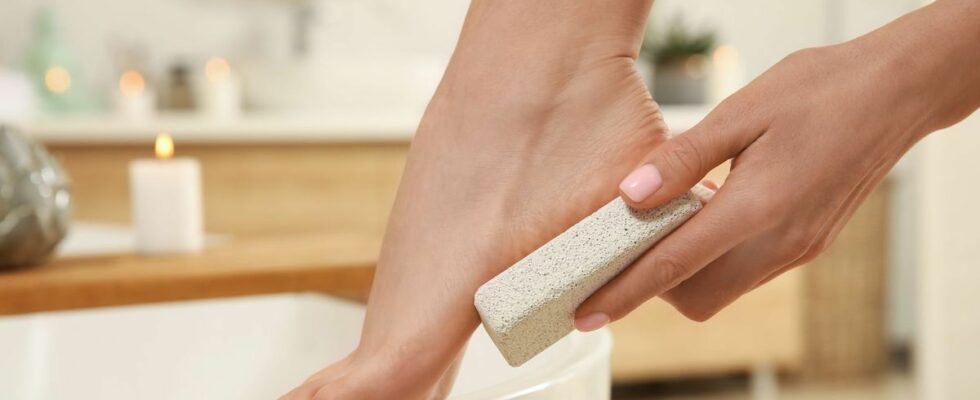Published on
Updated
Reading 2 min.
With the beautiful days, toes are out in sandals or bare feet. But to show off beautiful feet, it is important to take care of them. How to use a pumice stone properly? Here are some expert tips.
Taking care of the skin on your feet is essential, all year round. But this gesture is perhaps even more important in the summer, before slipping your feet into sandals. How to use a pumice stone? Experts enlighten us.
Taking care of the skin on your feet is essential
The skin on our feet, especially on our heels, is drier than that on our body. It therefore has cracks and calluses, especially since we stand on it, constantly putting pressure on it.
It is therefore essential to take care of this part of our body, through routines combining exfoliation and hydration. And for this, pumice stone can help you. According to Emily Splichal, certified podiatrist, “A pumice stone is made of porous natural lava rock, perfect for removing dead layers of skin“.
According to her, pumice stone can help remove excess skin, cracked heels or calluses on the soles of our feet. But be careful if you have a very deep crack in your heel or if you notice bleeding, experts recommend consulting a podiatrist. Finally, they remind you not to use the stone on areas affected by a fungal infection or plantar warts.
Should you wet your feet before sanding them?
A dry stone can be too abrasive and harsh on the skin and can cause injury.If a pumice stone is dry, it can potentially cause small tears, especially if used vigorously on sensitive areas.” explains Dr. Marisa Garshick, a dermatologist in New York City.
So always get it wet before exfoliating your feet. The ideal is also to “soak your feet in warm, soapy water for 10 to 15 minutes to soften your skin,” recommends Dr. Garshick.Next, wet the pumice stone and gently rub it over any callused areas you want to exfoliate, until you feel the skin feeling softer.”.
The best method of rubbing is to use a circular, back-and-forth motion. And “Medium pressure is needed to remove dead skin. However, too much pressure can cause injuries or cuts to the skin. It’s a delicate balance that depends on the thickness of your calluses.” she recalls.
How often should you use a pumice stone?
Pumice stone should be used a maximum of once or twice a week. “This frequency helps prevent over-exfoliation and allows your skin to recover between sessions. Using it too often can lead to skin irritation, redness or injury” warns the dermatologist again.
Similarly, be careful not to use pumice stone on delicate or inflamed skin areas. And once used, clean it with water and store it in a cool, dry place. “Make sure to keep the pumice stone as clean as possible as it can easily trap bacteria. Don’t leave them in the shower where there will be a lot of moisture” recommends Emily Splichal.
And if you suffer from diabetes, circulatory problems or if you are pregnant, ask your doctor for advice beforehand. Finally, once sanded, your feet must be carefully rinsed to remove dead skin. Finally, apply a moisturizer, to have a particularly soft sole of your feet.

